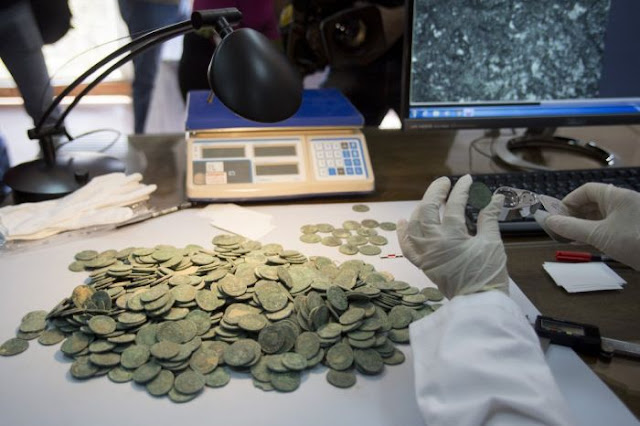
Making a great archeological find would be one of them most exciting things to happen to anyone. Unearthing a piece of our amazing planet’s past would be enough to fill almost anyone with a sense of joy and accomplishment. Well that’s precisely what happened to these construction workers in Spain. They were going about their day as if it was any other, when all of a sudden they made an absolutely incredible discovery. A discovery so big they couldn’t even unearth the whole thing! Check out what they found below.

The workers were digging a ditch to run electricity to a park when they came across these old-looking pots. These pots are actually called amphoras, and they were made during the time when Rome ruled much of Europe.

They cleared more of the dirt out that was surrounding the amphoras and discovered that they were full of what looked like coins!

There actually turned out to be 19 of these amphoras in the area. All of them were full the brim with bronze Roman Empire coins.

The weight of the coins totaled about 1,300 pounds! There were quite a bit of these things.

The coins date back to around the 3rd or 4th century A.D. The surprising thing is that researchers say that these coins were never in actual circulation.

These amphoras were commonly used to store and transport wine, olive oil and other food items.

The coins feature emperors Maximian and Constantine and are worth at least several million euros!

This set of coins is very intriguing to archeologists because it’s a very unique set. As was mentioned before, these coins were never used in circulation.

Researchers are eager to learn all they can from these coins and because of the mass amount, it’s going to take a while.

Once the coins are thoroughly examined by researchers, they will be placed into the Seville Archeological Museum for everyone to enjoy.

A collection like this has never been found before, so researchers are very anxious to see what knowledge they can glean from these coins.

It’s amazing that these amphoras and coins survived hundreds of years buried underground.

Making a great archeological find would be one of them most exciting things to happen to anyone. Unearthing a piece of our amazing planet’s past would be enough to fill almost anyone with a sense of joy and accomplishment. Well that’s precisely what happened to these construction workers in Spain. They were going about their day as if it was any other, when all of a sudden they made an absolutely incredible discovery. A discovery so big they couldn’t even unearth the whole thing! Check out what they found below.

The workers were digging a ditch to run electricity to a park when they came across these old-looking pots. These pots are actually called amphoras, and they were made during the time when Rome ruled much of Europe.

They cleared more of the dirt out that was surrounding the amphoras and discovered that they were full of what looked like coins!

There actually turned out to be 19 of these amphoras in the area. All of them were full the brim with bronze Roman Empire coins.

The weight of the coins totaled about 1,300 pounds! There were quite a bit of these things.

The coins date back to around the 3rd or 4th century A.D. The surprising thing is that researchers say that these coins were never in actual circulation.

These amphoras were commonly used to store and transport wine, olive oil and other food items.

The coins feature emperors Maximian and Constantine and are worth at least several million euros!

This set of coins is very intriguing to archeologists because it’s a very unique set. As was mentioned before, these coins were never used in circulation.

Researchers are eager to learn all they can from these coins and because of the mass amount, it’s going to take a while.

Once the coins are thoroughly examined by researchers, they will be placed into the Seville Archeological Museum for everyone to enjoy.

A collection like this has never been found before, so researchers are very anxious to see what knowledge they can glean from these coins.

It’s amazing that these amphoras and coins survived hundreds of years buried underground.
Credit : buzznick.com




